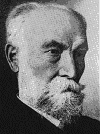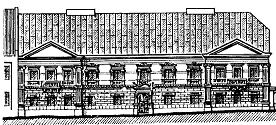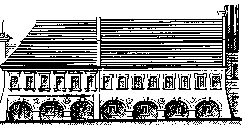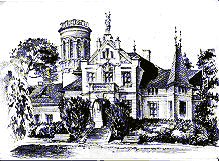The Museum was established by the Polish Country Lovers Society in 1908. This newly created institution was devoted to prehistory, history and natural history of the Swietokrzyski Region. The first director was Szymon Tadeusz Włoszek, a teacher, a participant of the January Uprising, a man experienced by life, and severe with himself as well as with people in his surroundings. At the same time he was conscientious and reliable.
In 1910 the museum already had 1986 catalogued things. A piece of the petrified tree from Miedziana Góra from the Feliks Rybarski’s collection was the first position in the inventory of the Museum. Despite collecting historic souvenirs was banned by tzar, the curator gathered a lot of things, especially connected with the January Uprising.
Museum objects were gathered in many different ways, also per fas et nefas. A good example might be a history of the old drum from 1830. Zdzisław Lenartowicz, a painter, noticed the drum in the church in Wzdół. He knew that the parish priest was reluctant to get rid of his belongings and he decided to steal the drum. So he took the drum to pieces, let it down from the church tower and brought it to Kielce. The priest was very stubborn and took his drum back with force. Everything took place on 11th June 1912. In 1922 some attempts were taken to take the museum collection to the former bishops’ palace but they were fruitless. In the magazine “Ziemia” (The Earth) from 1930 we may find some information about the Polish Country Lovers Society Museum: “It has one of the richest collections of the regional objects. The collection is situated in one-story building on Leonard Street, which is rented for the annual fee of 1600 zł. The premises include three exhibition rooms, a curator’s flat (one room + kitchen) and a library. Two exhibition rooms are quite small – 2,5 x 4 m, the third one is bigger – 4 x 6 m. Natural and archeological objects are still not described; prof. Tadeusz Włoszek explains everything at once.”
When Szymon Włoszek died in 1933 r., the management of the Museum was taken over by Sylwester Kowalczewski. He was a teacher and a regionalist. One of his most crucial actions was organizing in 1936 in Warsaw the Exhibition of Świętokrzyski Region. From this year the Museum was called Świetokrzyskie. In 1938 in the south-west part of the Kielce Palace’s ground floor the Sanctuary of Marshal Józef Piłsudski and the Museum of Legions were established. Attendances in the first 30 years of the Museum increased up to 58.100 visitors. The activity of the Museum was interrupted by the Second World War. Although a lot of objects were hidden thanks to Edmund Massalski, huge part of the collection was destroyed or just stolen by occupying army.
Although collections of the Museum were partly scattered, the Museum managed to resume its activity immediately after the Second World War. The first director after the war became Juliusz Nowak Dłużewski
In 1946 the first exhibition was open. The Museum’s director in the years 1946 – 1961 was Edmund Massalski – a naturalist and regionalist. He changed it from lumber-room into institution organizing specialist exhibitions and studies; initiated establishing new museums in the Kielce region. In 1952 he wrote to the town authorities: “Exposition was prepared in four rooms what significantly limited the number of presented objects. The present exhibition initiates further exhibition action and there will be next ones”.
In 1952 Massalski wrote: “We have only 4 scientific employees. There is a need for educational instructors and their salary should not be less than 600 zł. The museum is bereft of funds for scientific publications; we do not have any technical staff; our buildings are not guarded”.
The first exhibition after war was organized by Zygmunt Włodzimierz Pyzik and Janusz Kuczyński. It was an archeologist exposition and was accompanied by a guide book “Prehistory of the Kielce Voivodeship Area”. In 1958 there were a few regional museums established – the Museum of Henryk Sienkiewicz in Oblęgorek, others in Szydłów and Czarnolas.
In 1961 the director Massalski retired and his post was taken over by Alojzy Oborny, an art historian, so far director of museum in Racibórz. As the state of the museum buildings was terrible, his first action was to organize their renovation. The activity of the Museum was not interrupted.
In 1965, thanks to eagerness of Aleksandra Dobrowolska, who was the inventor of the previously listed biographic museums, the Museum of Stefan Żeromski was established. The Museum of Henryk Sienkiewicz in Oblęgorek was growing in popularity and in 1967 was seen by 80 000 visitors. “The Yearbook of the Świętokrzyskie Museum” started to be published. As some plans of creating the Gallery of Polish Painting appeared, Museum bought paintings by Lampi, Siemiradzki, Kostrzewski, Grottger, Brandt, Wyspiański, Pankiewicz, Boznańska and many others. The Museum became more and more active – played a host of the National Festival of Films about Art; developed its permanent exhibitions of historical and ethnographic ones, as well as the Gallery of Polish Painting.
In 1971 a 17th - century Bishops’ Palace became a new premises of the Museum. At the same time restoration of the Palace began. The first exhibition was presented within 8 months since a take-over and the palace was called “Kielce Wawel” by prof. Stanisław Lorenz. In 1974, a number of visitors exceeded 100,000. In recognition of Swietokrzyskie Museum's achievements in 1975 it gained the rank of the National Museum.
Since this time over a quarter of the century has passed. There is no need to list all exhibitions and different kinds of activity that have been honored in Poland and abroad. It is enough to say that from small provincial institution it developed into huge and active museum.
We have managed to remind two great Polish painters – Józef Szermentowski and Władysław Aleksander Malecki. In 1998 in the renovated north wing of the palace the Gallery of Polish Painting and Decorative Arts opened. Due to director Alojzy Oborny’s efforts the renovation of the palace was finished, a lot of building works were done; his last initiative was a reconstruction of Italian garden. However, it must be mentioned here that without goodwill of Voivodship Governors, Marshals and Presidents of Kielce, realisation of many of these ideas would not be possible.
In 2003 the director of the National Museum in Kielce became prof. Krzysztof Urbański. He had already been a director in the years 1987-1990. He continued realization of already started projects and took up a few totally new initiatives. During these last 5 years there were a lot of exhibitions including monographic ones: “Wojciech Siudmak’s Fantastic Worlds”, “Danuta Leszczyńska – Kluza”, “Leszek Mądzik”, “Leon Wyczółkowski – in the 150. anniversary of the artist’s birth”, “Karol Hiller. New perception painting, heliographic, drawing, graphics”. From other expositions worth mentioning are: “Art of Kielce region after 1945”, “Mythological motifs in fine arts” and the biggest “Passion of collecting”. The last one was prepared in cooperation with the Royal Castle in Warsaw and presented in Kielce from September 2007 to February 2008. “Passion of collecting” was a presentation of more than 1000 objects (European and Eastern weapons, decorative arts, painting) gathered by Ryszard Z. Janiak - a collector from Łódź.
 Szymon Tadeusz Włoszek (1843-1933) – a veteran of the January Uprising – on 10th October 1908 wrote into the inventory book the first object (a piece of petrified tree). As no founding document has been found this day was taken as a date of the museum foundation
Szymon Tadeusz Włoszek (1843-1933) – a veteran of the January Uprising – on 10th October 1908 wrote into the inventory book the first object (a piece of petrified tree). As no founding document has been found this day was taken as a date of the museum foundation
 Building on Leonard Street in Kielce – the premises of the Museum from 1913 to the Second World War
Building on Leonard Street in Kielce – the premises of the Museum from 1913 to the Second World War
 "House under Three Coats of Arms" – main premises of the Museum in the years 1945 – 1971. Till 31st July 2000 both permanent and temporary exhibitions were presented there. At present there are departments as follows: archeology, nature, library, conservatory and photographic workshop, storerooms. Also Polish Contemporary Art Gallery is located there.
"House under Three Coats of Arms" – main premises of the Museum in the years 1945 – 1971. Till 31st July 2000 both permanent and temporary exhibitions were presented there. At present there are departments as follows: archeology, nature, library, conservatory and photographic workshop, storerooms. Also Polish Contemporary Art Gallery is located there.
 Former Cracow Bishops' Palace – the premises of the Museum since 1971. At present one may see there historical interiors from the 17th and 18th c., permanent weapon exhibition, the Sanctuary of Marshal Jozef Pilsudski; in the north wing – the Gallery of Polish Painting and in the backyard of the palace – Italian garden.
Former Cracow Bishops' Palace – the premises of the Museum since 1971. At present one may see there historical interiors from the 17th and 18th c., permanent weapon exhibition, the Sanctuary of Marshal Jozef Pilsudski; in the north wing – the Gallery of Polish Painting and in the backyard of the palace – Italian garden.
 "National gift" for Henryk Sienkiewicz in 1900 – mansion in Oblęgorek - became the premises of the Museum of Henryk Sienkiewicz in 1958 and on 1st January 1976 – the branch of the National Museum in Kielce.
"National gift" for Henryk Sienkiewicz in 1900 – mansion in Oblęgorek - became the premises of the Museum of Henryk Sienkiewicz in 1958 and on 1st January 1976 – the branch of the National Museum in Kielce.
 Building of the school which Stefan Zeromski went to (Men’s Governmental Secondary School). Since 1964 the premises of the Museum of Stefan Żeromski’s School Days, branch of the National Museum in Kielce.
Building of the school which Stefan Zeromski went to (Men’s Governmental Secondary School). Since 1964 the premises of the Museum of Stefan Żeromski’s School Days, branch of the National Museum in Kielce.









